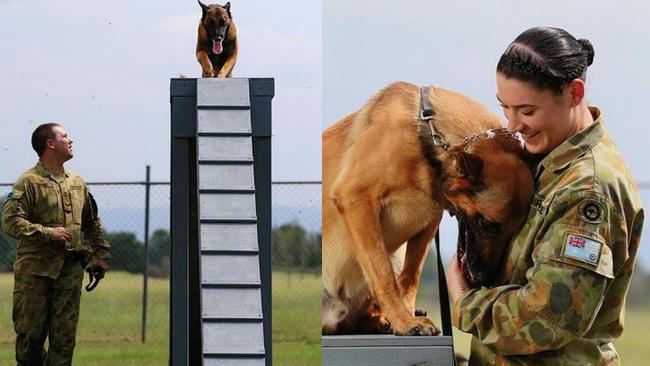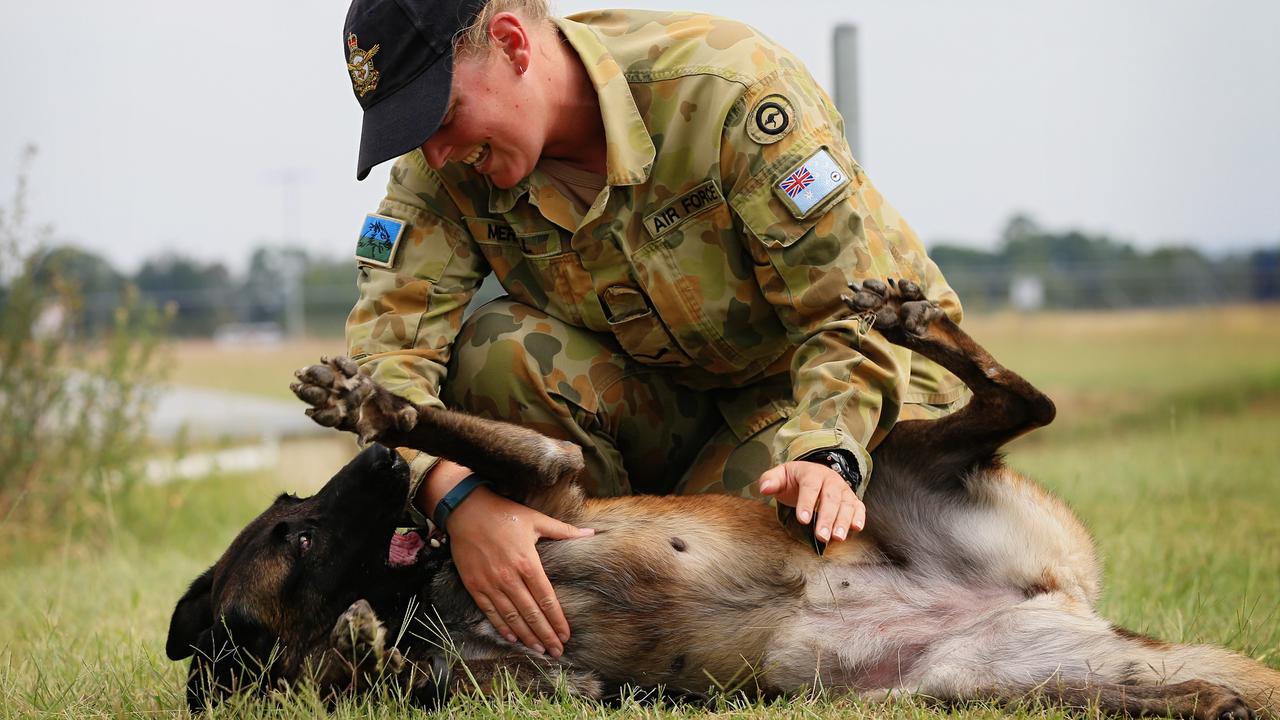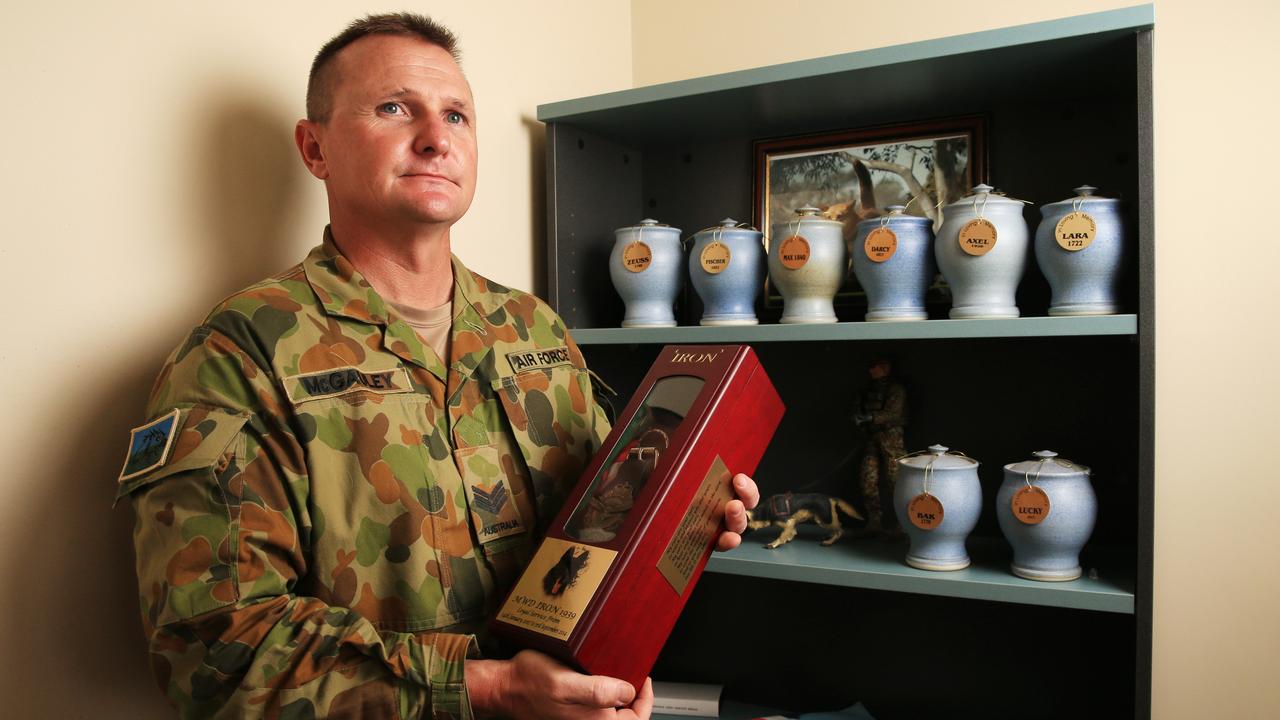THE ATTACK
AS soon as Leading Air Craft Woman Sarah Merrill walked out to the training area carrying the bite suit, the demeanour of Flynn, a 9-year-old Belgian Shepherd Malinois, changed instantly. Just a few seconds earlier he was lounging around with his handler, Corporal Patrick Hanley, seemingly without a care in the world, happy to receive a pat and offer a friendly lick in return. But then his ears pricked up and his intense gaze stayed on Merrill as she walked towards the wire pen.
Once she was strapped into the 15kg suit and entered the training area Flynn was raring to go.
His teeth bared, saliva dripping from his mouth, he barked ferociously. In an instant he had transformed from a friendly dog into a possessed canine in full working mode.
Merrill stood just footsteps in front of him, edging him on, while Flynn pulled on his leash eager to attack and do what he’s trained to do - take down anyone who poses a threat.
In seconds he was unclipped from his leash and he lunged at her, biting down hard into her arm.
As instructor Sergeant Anthony McGauley explained there is pressure of 28kg per square centimetre when the dogs bite down - twice the amount of your average dog.
“The suit’s heavy and it’s hot and it’s intimidating and scary and then you have this dog that one minute you’re feeding it and patting it and then the next minute its body’s changed,” said Merrill who unfortunately drew the short straw and had to don the bite suit.
“There’s fire and fight in the eyes of the dog so it’s really good scare tactics and then there’s that element of suspense of when it’s going to hit.”
She explained how some of the dogs will lunge so hard they literally push you over and there is an almighty force either on your arm or back.
“I don’t think I would ever want to be on the receiving end without a suit on. There would be no way I would ever want to go into a life of crime to have that happen to me,” she said.
But there’s more to these dogs than just their bark and their bite.
THE ROLE OF THE RAAF DOG
The dogs and their handlers are responsible for providing security, crime prevention patrols, emergency response and intruder detection, both on RAAF bases across Australia and in deployed locations around the world.
The RAAF have never taken their dogs to the Middle East and won’t be joining the 400-plus troops Tony Abbott has recently committed to Iraq.
“There’s a big culture difference over there with the way they view dogs. They don’t like us bringing our dogs,” McGauley, who has 20 years’ experience in the dog squad, explained.
McGauley did however deploy to East Timor in 2000 and 2010 with his old dog Ben.
“When we went to Timor that was the biggest shock for them (locals), their little camp dogs were about 20 kilos so our dogs looked like lions,” he said.
“We would go to the beach for a swim with the dogs and we would clear the beach.”
The two main breeds of military working dogs used by the RAAF are the German Shepherd and the Belgian Shepherd Malinois. The dogs mostly come from the Air Force’s own breeding program, and members of the public can volunteer to foster puppies.
These dogs are their family.”
McGauley said the Shepherd is the preferred breed used because of their “high intelligence, agility and their trainability”.
“We’ve tried other dogs over the years but overall these two breeds are the cream of the crop for us,” he said.
And not just any dog goes to any handler: dogs and handlers are carefully matched to ensure they will work well together.
“We’ll actually view the handler coming through the training to look at their personality traits and work out what they are like and then we’ll sit down and try and match personalities of the handler to the dog,” he said.
Once matched, the handlers and their dogs work together closely to keep their fitness and training in top condition as both are tested regularly to ensure they are ready to deploy at any time.

THE BOND BETWEEN HANDLER AND DOG
From the outset it was evident how attached to their dogs the handlers are. This is much more than just a working relationship: these dogs become part of the family.
“For a lot of these guys, especially the young ones who are away from home and don’t have family these dogs are their family,” Sergeant McGauley explained.
Leading Aircraft Woman Celia Monahan feels pretty lucky to work with her dog every day.
“It’s amazing, you can’t beat a bond with a handler and a dog,” she said.
“You do always miss them on your days off but when you see them, to walk in that kennel and have those dogs going crazy because they just want to get out and be near you, you can’t beat that.”

And the relationship doesn’t end when the dog retires, due to age or illness. If possible the handlers take their dog home to live out the rest of their days as the family pet.
A number of checks are undertaken to ensure the dog will be suitable for family life and those checks are carried out internally by the RAAF as well as the RSPCA.
But the bond continues even after death. The Air Force pays for each dog to be cremated and while some urns will go home with the handler others take pride of place on the base.
Corporal Hanley, like the rest, said the attachment between the handlers and dogs makes it even more difficult when the time comes to say good bye.
“It does affect everyone in the section. It does get to you because you’re used to seeing that dog there and then one day they’re not there anymore,” he said.
Sergeant McGauley still keeps a photo of his beloved dog Ben which he proudly showed off, the admiration and love still clearly present.


Here’s what you can expect with tomorrow’s Parramatta weather
As spring moves into summer what can locals expect tomorrow? We have the latest word from the Weather Bureau.
Here’s what you can expect with tomorrow’s Parramatta weather
As spring moves into summer what can locals expect tomorrow? We have the latest word from the Weather Bureau.